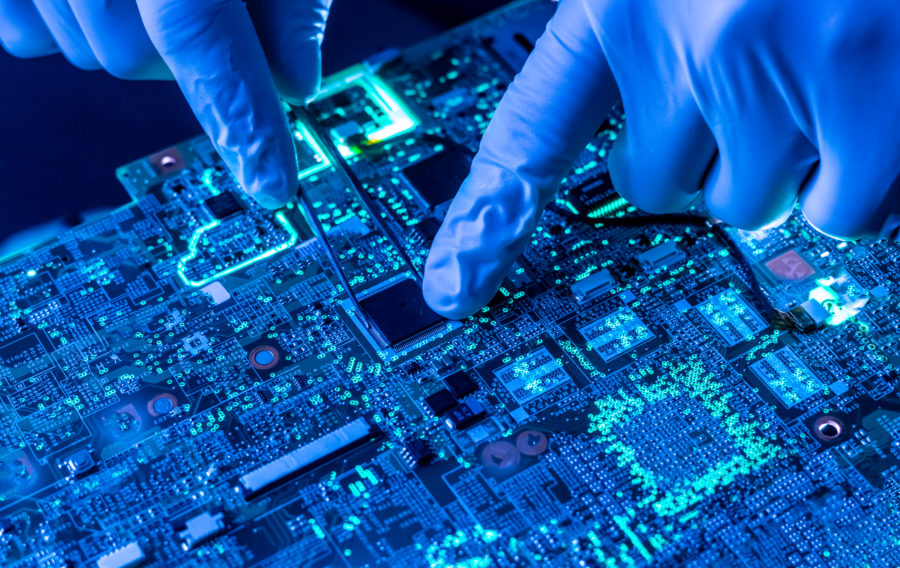
Defence Online’s Ciara Houghton examines how advances in technology are leading to government’s exploring the military use of nanotechnology.
Advancing technology means that important components needed to power products can be made smaller. This includes batteries, aerials, and data storage chips. The first every hard disk drive, invented in 1956, was the IBM Model 350 Disk File which was the size of a cupboard and could hold about 5mb of data. Toshiba recently released a 16 terabyte hard drive around the size of a coaster. Powerful cameras and sound recorders can also be realised on a very small scale enabling surveillance technology that is extremely difficult to spot and harder to destroy.
Nanotechnology holds huge promise for medicine, with scientists researching how tiny robots can swim through the human bloodstream to ensure drugs are being delivered and even how they could combat cancer. As well as creating smaller devices, nanotechnology can improve other aspects of military technology such as manufacturing, body armour, health monitoring, and even detecting chemical weapons.
Governments across the world are exploring nanotechnology in surveillance for military purposes. Near-invisible tiny cameras can be easily hidden in drones and other equipment to provide reconnaissance data and intelligence. This has proved a point of contention for ethicists and even conspiracy theorists, but some of the more outlandish ideas are not far from the truth.
China has developed surveillance drones that look like birds to collect data from across the country. Russia and the United States have taken similar measures, disguising drones as birds and even insects. Many of these ideas are still in the early stages, but the scaling down of technology makes it possible. Currently, the world’s smallest camera is the size of a grain of salt and is used for medical purposes.
Concerns over surveillance nanobots range from worries over privacy to potential health concerns and environmental hazards. Insect-sized robotics have numerous applications, including maintaining the environment, and nanobots can be programmed to work in ‘swarms’. A large number of robots can be controlled to act as one, making them even more difficult to combat.
There is an environmental concern too, nanobots, like microplastics, would be difficult to clean up after use and could even be ingested by people and animals. It is unknown what kind of impact they could have on the environment and people’s health. They could contain chemicals like mercury and if left this could leak into the environment. They could even contribute to litter in the ocean and space, with unknown effects. Insect-sized bots that could enter people’s homes unnoticed and be equipped with technology such as face recognition is a scary concept.
The US military has been experimenting with nano drones for reconnaissance purposes. The Black Hornet Personal Reconnaissance System (PRS) from FLIR systems is fitted with a camera and thermal imaging and has a flight endurance of 25 minutes and a range of up to 2km. The standard model weighs 33 grams and is 16.8 cm long. The latest model, the Black Hornet 3 nano-UAV can fly in areas without GPS capabilities, has an improved data link and higher quality image capability. It can fly at speeds of 21km/h and can operate in temperatures between -10°c and 43°c.
The drones are controlled on the ground with remote control systems weighing less than 1kg and AES 256 encrypted communications. The drone has proved highly popular with armed forces organisations across the world. Over 30 countries have expressed interest in the drone. FLIR systems won a $39.6million contract with the US military for the Soldier Borne Sensor Program earlier this year to start its ambition to provide all 7,000 squads in the army with a Black Hornet PRS.
The British MOD awarded the company a $1.8million contract for the drones and the French Military awarded an £89million contract to FLIR. Around 8,000 of the drones are currently deployed in 30 countries. Multiple tiny drones can be deployed as swarms which confuse enemy radar. The US DOD is aiming to develop its own nano drones to bypass enemy sensors. Researchers at Purdue University developed tiny drones designed to look like hummingbirds. The drone mimics the flight of the bird and was trained through an algorithm based on research into birds.
Military organisations are exploring how nanotechnology can be used to create new fabrics to enhance soldier’s performance, keep them safe, and even regulate temperature. In Canada, experts from the University of Alberta are exploring how nanotechnology can help create new textiles. Through a $1.5million government grant, scientists are working on ‘Comfort-Optimized Materials for Operation Resilience, Thermal-transport, and Survivability’ (COMFORTS).
The project is organised into eight smaller objectives, tackling issues faced by the Canadian armed forces. Patricia Dolez, a textile scientist, is mostly focussed on creating a material that uses nanofibres to protect against chemical and biological threats that also is light and doesn’t make the wearer too hot. This will utilise electrospinning, which weaves together nanofibres to create effective filters.
Temperature control is another focus, engineering professor Kevin Golovin from the University of British Columbia Okanagan is researching a flexible fabric that detects comfort levels with built-in sensors and can adapt to the environment, protecting the wearer from extreme temperatures. The project also includes a layer designed to keep the wearer dry using Dolez’s previous research into hydrophobic nanofibre fabrics. This will be included as an additional layer. One layer is being tested to protect against flames and extreme heat at a special facility at the University. The team is also researching lightweight and comfortable bulletproof materials that can keep soldiers safe without weighing them down.
One potential innovation that could prove invaluable to the military is nanogenerators. Nanogenerators look like tiny, flexible computer chips and utilise nanowires measuring 200-300 nanometers thick to generate triboelectric power. When contact is applied to the generator the nanowires create static electricity through close contact and send it to one of the electrodes built into the circuit.
This pressure can come from movement, manipulation, or even involuntary bodily processes like your pulse or the function of organs. Naturally, they’re a huge point of interest for medicine, potentially providing a reliable low-maintenance source of power for medical devices like pacemakers that could be implanted with little impact on the patient.
They could also be incorporated into clothing and used to power devices like phones. This kind of technology could be extremely useful to the military, a lightweight, environmentally friendly generator that can be worn on the skin or placed within a soldier’s uniform fabric. One potential use of nanotechnology being actively researched is how it can be used to track and secure military equipment during delivery. Theft of defence equipment in transit is a huge problem in the military supply chain, particularly in the US.
The DOD has used Radio Frequency Identification to track and identify packages but is looking to scale down the processes. Nanotech can help provide unique ‘fingerprints’ to secure the identity of merchandise and improve security through nanodevices such as encrypted chips in labels. The information can be stored through IoT to prevent fraud.
If you would like to join our community and read more articles like this then please click here.
Body Armour Drone intelligence Medical nano reconnaissance Research







